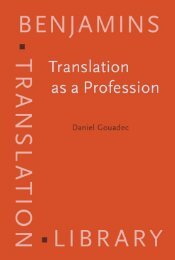Constructing a Sociology of Translation.pdf
Constructing a Sociology of Translation.pdf
Constructing a Sociology of Translation.pdf
- No tags were found...
Create successful ePaper yourself
Turn your PDF publications into a flip-book with our unique Google optimized e-Paper software.
128 Mirella Agorni1995; Hermans 1996; Chesterman 1997), a concept which gives prominence tothe social environment <strong>of</strong> translation.Generally used to map socially acceptable behaviour, norm theory envisagestranslation as a socially patterned type <strong>of</strong> linguistic communication. Norms are tobe understood as codes employed to “decipher” translators’ strategies and choices.Not only do they play a fundamental role at the production pole, but they are also<strong>of</strong> vital importance at the reception end/pole, where they establish “what a particularcommunity will accept as a translation” (Hermans 1999: 77–78).No longer focusing merely on their apparent prescriptive nature, scholarsprogressively have stressed the productive aspect <strong>of</strong> norms (Toury 1998). 4 Bypresenting a regulated choice <strong>of</strong> behaviour, norms do not impinge on translators’agency; on the contrary, they assist translators in their process <strong>of</strong> decisionmaking.Translators’ room for manoeuvre also appears to be guaranteed by thediachronic flexibility <strong>of</strong> norms: since they are produced by social and historicallyspecificcommunities, they are subject to change over time.The strength <strong>of</strong> norm theory lies in its capacity <strong>of</strong> bringing together socialand individual features <strong>of</strong> translation, as they ultimately <strong>of</strong>fer the practitioner asocially acceptable repertoire, from which s/he can select their choices. However,there is an important aspect which has to be clarified: as has been pointed out,the definition <strong>of</strong> norms depends on social groups and institutions, conventionallynamed “communities”. Communities are socially-culturally- and historically-specific,and can be visualised in systemic terms. 5 In order to integrate norm theoryinto a methodology capable <strong>of</strong> dealing with the complexity <strong>of</strong> translation phenomena,we still need some theoretical instruments which would enable us totackle the materialist specificity (i.e. the contingent social and historical nature)<strong>of</strong> the forces at play in translation.. In this article (Toury 1998), which deals at length with the social nature <strong>of</strong> the norms concept,Toury lays special emphasis on those aspects <strong>of</strong> norms, which are produced by social andhistorically-specific communities in order to regulate (and facilitate) translators’ processes <strong>of</strong>decision-making.5. Rakefet Sela-Sheffy has provided a very useful description <strong>of</strong> the complex forces involvedwith translation practices: “editors, publishing houses or commercial companies, and their policy<strong>of</strong> encouraging or discouraging translation, translation criticism, prizes and grants, translators’associations and clubs” etc. (2000: 353). The author stresses the fact that these heterogeneousforces are hierarchically ordered, in a state <strong>of</strong> dynamic interaction. Side-by-side withthis materialist description <strong>of</strong> the forces at play in translation, we should not forget anotherinterpretation <strong>of</strong> “community”, the “imagined communities” seminally described by the historianBenedict Anderson (1983). In spite <strong>of</strong> their fictitious character, “imagined communities”brought about very concrete effects, such as the rise <strong>of</strong> a sense <strong>of</strong> national identity in certainhistorical periods (such as the eighteenth century).
















